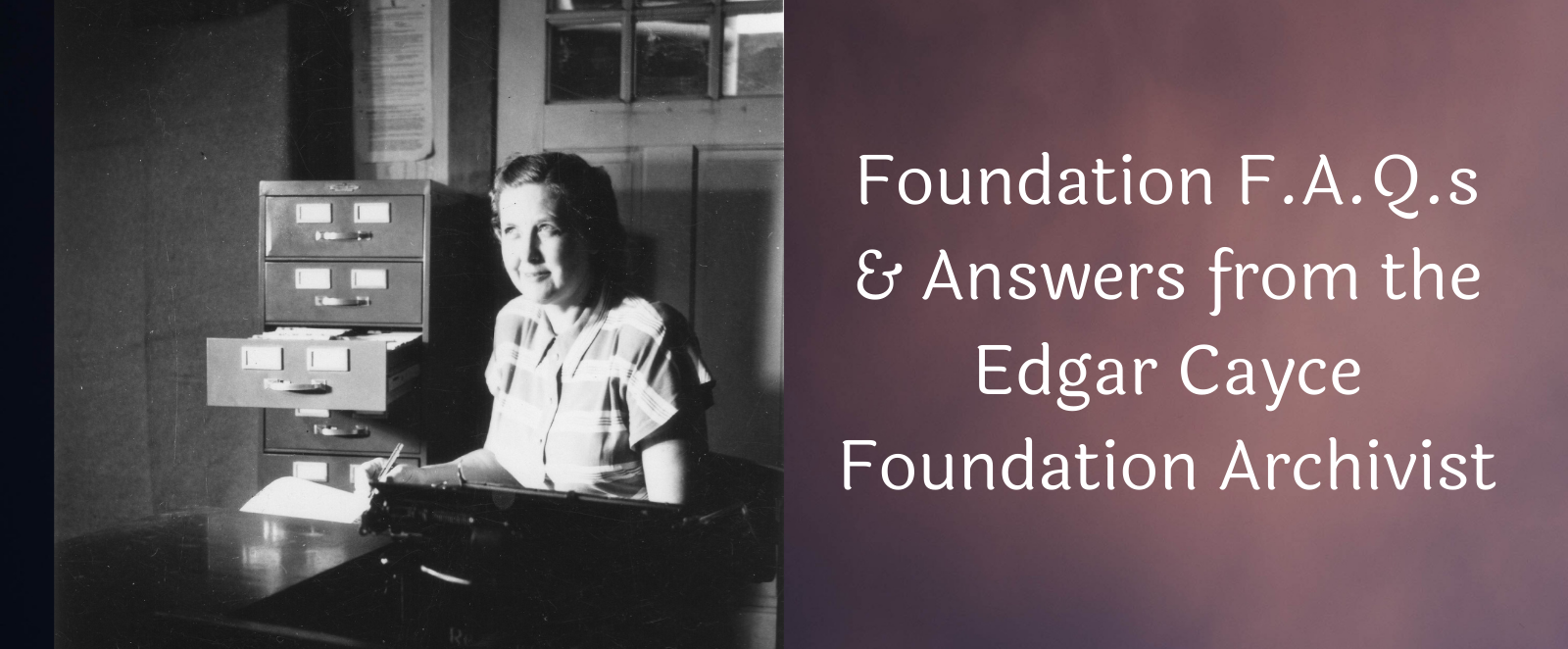I love helping people make discoveries in the Edgar Cayce Foundation archive. I’ve received many questions about how it all works - and why. I thought it would be helpful to answer some frequently asked questions about using the archival materials in the E.C.F.
What’s in the archive?
Archives are collections of “records created or received by a person, family, or organization and preserved because of their continuing value.”(1) These records can be all kinds of things - letters, diaries, audio discs, blueprints, business and financial records. The E.C.F. was founded in 1948 to take care of Edgar Cayce’s readings, including the transcripts, reports, letters, and any other form of record generated by Edgar Cayce’s communications with people who had readings. Apart from papers and photographs, there are some more unusual items such as x-rays, plant samples, and locks of hair. The archive expanded over time to include Cayce family records, organizational records of A.R.E. and Atlantic University, personal papers of early A.R.E. members like Ruth LeNoir and Elsie Sechrist, and much more.
How is it all organized?
Archivists do their best to preserve original order, or how the creator arranged the records in the first place. By preserving original order, we maintain the historical context of the records as well as the knowledge of how this information was used by people in the past. For example, the Cayce Readings are arranged using the same folder naming convention used by Gladys Davis and her staff. But instead of a long row of file cabinets, the readings now live in 299 individual boxes. There are over 30 distinct collections in the archive, which are all organized in boxes and folders.
What is a finding aid?
A finding aid is a document that describes the contents of a collection. While library catalogs help you find an individual book, finding aids provide you with detailed inventories of each collection’s contents, tell you where the collection came from, biographical information of the records’ creators, and how everything is arranged. Finding aids describe collections at varying levels of detail, but the majority of E.C.F.’s collections are described down to the folder level. Go to edgarcaycefoundation.org and click “Search the catalog,” then go to “Collections” to view our finding aids. They give you a great idea of how complex and varied our archival holdings are.
Most of the questions I get relate to the Edgar Cayce Readings. Some confusion persists about how they are accessed, as well as how they can be used. The readings collection is and always will be open to research by anyone, but is unique among our other collections for these reasons below...
Why are reading recipients referred to by their number?
Each person that had a reading from Edgar Cayce was given a number. Originally, they were numbered chronologically by the date the reading was given. The number system helped Gladys Davis, and later her staff as well, to keep these “case files” organized and recipients’ identities private. In 1959, the Remington Rand company submitted an indexing plan that randomized the case file numbers, which is how they are organized today.
Why are the names of some reading recipients private?
The first research projects to study the readings, which began in the late 1940s, used redacted readings. Gina Cerminara wrote her book Many Mansions according to this practice, as did other authors that followed. The Foundation always balanced the need for access with the desire to respect the privacy of the people whose personal histories, including health and interpersonal information, are reflected in the archival material. In writing the confidentiality guidelines of today, we looked at Gladys Davis’ working procedure in addition to other primary sources that tell us how the privacy of individuals was protected. For example, staff member Jeanne Schultz wrote a memo to her colleague Vaughan Shelton about writing to reading recipients for reports. Jeanne wrote, “Stress the fact that we do everything under the sun to keep their individual identity in strictest confidence, and never is their readings and/or correspondence ever seen outside of the Vault office - room unless their name and all revealing identification is first removed and their own case number substituted. Perhaps include a wager that if they were to see their own case “done up” they wouldn’t even recognize it themselves.”(2)
We’ve recognized that with the passing of time, the need for keeping names private decreases as the recipients and their spouses and children pass on. That’s why we ask any researcher who has researched a recipient, and would like to publish their findings using the person’s name, to follow a simple approval process. In most cases, all of the people are deceased and the name can be published. These released names can be viewed on our website.
Sometimes we have dialogue with a family who does not want a name made public, and so we honor that wish out of respect. This doesn’t mean that the researcher’s project is off-limits - we encourage them to still publish their work but refer to the reading recipient by their number. These cases are few and far between. Eventually, all of the names will be public knowledge.
Do you have to be an author to use the archive?
The E.C.F. welcomes anyone to make an appointment to do research. We help A.R.E. members, staff, conference presenters and speakers, outside researchers, including those affiliated with a university, company, or seeking information for personal interest, and members of the local Hampton Roads community. It’s been rewarding to see the variety of projects that have come from the archival material, from a thesis written by a Ph.D. student from Germany to an Edgar Cayce-inspired musical. The possibilities are pretty much endless.
What is citation and why is it important?
A citation is a reference to a source found during your research and used in a project, such as an article or a talk. Archivists love it when you cite your sources! Citation benefits you, as it builds trust in your work. It helps your audience, because they can follow the road map of your thought process and see to whom you “spoke” along the way to build your perspective on a topic. It also shows respect for your sources and the real people behind them. You may have noticed the footnotes in small print at the bottom of the Cayce Chronicles column that I write in Venture Inward magazine. I include those citations because I want you to know exactly where I found each piece of information. That way, you can be sure that the stories I share with you are true.
Are there stories we can’t know are true?
Edgar Cayce did many miraculous things in his lifetime. “The desire to put on the sensational,” as Edgar once put it, can be tempting sometimes.(3) I’ve often been asked about certain stories about Edgar and if they have any basis in fact. These anecdotes, such as Thomas Edison, Nikola Tesla, and Woodrow Wilson receiving readings, among others, are not supported with the physical evidence that we have in the archive. Preserving the readings has meant that I’ve touched every piece of paper in every case file, and can vouch that there are no documents that can corroborate these stories. It’s enjoyable to speculate, but until we find solid evidence, these stories must remain in the world of enjoyable speculation. And trust me, I’m not keeping a secret box in the back of the storage room. Show me the evidence and I will join you on the roof to proclaim our great joy for all to hear.
I feel a responsibility to be an advocate for the people represented by these records who are no longer with us. We all know that misinformation is a problem, especially online. Edgar’s story is just as susceptible to historical inaccuracy. I encourage you to read with open eyes as well as an open heart. Does this story seem plausible? Where did this person get their information? We all can ensure that Edgar’s story is told with integrity.
What’s next for the E.C.F.?
For the past three years I’ve been organizing and preserving over 300 linear feet of paper records in the archive, and adding them to our online catalog. I now can see the light at the end of the tunnel! Once the paper records are done, the Foundation will be starting its digitization projects, which will include our photographs, audio recordings, and film. It will be a long process, but at the end of it will be a dynamic and wonderfully rich online experience of the history of the Work for everyone to enjoy.
Have more questions about the archive? Please submit them to ecf@edgarcayce.org and I’ll feature them in a future F.A.Q.
________________________________
Photo caption: Gladys Davis in the Edgar Cayce Foundation office, 1950, E.C.F. Photography Collection.
(1) Dictionary of Archives Terminology, s.v. “archives,” accessed July 21, 2021 https://dictionary.archivists.org/entry/archives.html
(2) Interoffice memo, Jeanne Schultz to Vaughan Shelton, February 6, 1959; Edgar Cayce Foundation Collection, Coll. 23, box 14, folder 4, The Edgar Cayce Foundation, Virginia Beach, VA.
(3) Edgar Cayce, “Introduction,” 1924; Gladys Davis Turner Collection, Coll. 8, box 8, folder 3, The Edgar Cayce Foundation, Virginia Beach, Virginia.






